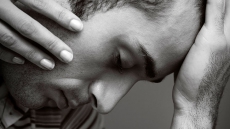There's a lot to be said for the work/play energy of a nice studio or other small apartment during the day. But how do you bring that energy down to get a good night's sleep?
With electronics, cookery, clothes and books all in one space, it can be a challenge to create a restful refuge.
Design and sleep experts have some tips:
Prioritize a sleep space, starting with the bed
Everyone needs good sleep to stay healthy.
“The primary rule, maybe the only rule of small space design, is people have to be honest about how they really live,” says Olivia Hosken, House Beautiful’s deputy managing editor. "When there’s limited square footage, there’s less allowance for things that don’t function optimally."
So, spend your money on a proper bed or a quality sleep sofa. Skip big tables or chairs you won’t use, she added.
Andrea Morris of Lancaster Place Interiors in Wilmington, North Carolina, is a fan of wall beds, which rest flush with the wall when closed, then flip down for sleeping. They’re better known as Murphy beds, named after William Murphy, who came up with his version in 1900 while living in his own San Francisco studio apartment.
Some Murphy beds combine a sofa with a wall bed.
Create a buffer zone
To separate your sleep area from the rest of the apartment, you could get a freestanding screen, room divider or “floating" (hanging) wall.
And as much as you can, keep that area strictly for sleeping.
“Avoid doing work or anything stressful from your bed,” says Jeff Kahn, co-founder of the Chicago-based sleep-research company Rise Science, which developed a sleep-tracking app, Rise.
“This helps to maintain what sleep medicine practitioners call ‘stimulus control,’ which helps your brain associate the bed with sleep, rather than wakefulness and stress,” he says.
If the bed is the only place of refuge, still do what you can to keep wakefulness and sleep in separate zones. Lisa Strauss, a psychologist specializing in cognitive behavioral treatment of sleep disorders, has suggested designating different sides or ends of the bed for reading and sleeping.
Freshen the air. Lower t
he lights. Cut the noise.
“Make sure your space is well ventilated, and consider an air purifier,” says Kahn. This is especially important if you're cooking in the same space you're sleeping in.
Consider a diffuser for similar reasons, says Spruce editor Mia Ingui. She suggests using calming scents like lavender or chamomile just at bedtime, to "set the tone for restful sleep.”
Also, be sure that computer, TV and other screens, which are just a short distance away, are turned off. Their light at night can disrupt our internal clocks, or circadian rhythm.
If the buzz of nearby appliances or street sounds are keeping you up, consider a noise machine. Ingui likes the Hatch Restore, a “sunrise lamp” that provides soothing sounds and lights up gradually in the morning. She also suggests blackout curtains.
Keep things tidy
“One of my don’ts when it comes to studio living is leaving beds unmade,” says Morris. "It’s amazing how much better you feel after a hard day entering a space with a made bed. And in a studio, it’s often the sofa, too. So make it inviting for yourself and others.”
Stow away electronics overnight and out of sight; side tables with plugs and ports are handy and an efficient way to reduce clutter.
Choose flexible, storable bedding
Ingui recommends choosing breathable materials for bedding if it’s difficult to regulate your studio’s heating and cooling.
“It’s also great to invest in a duvet cover/insert rather than a bulky comforter — this way, you can easily keep multiple foldable, storable covers on hand and swap them out, rather than hoarding a bunch of large comforters you don’t have space for,” she says.
With some thoughtful choices, your small space can have the vibes we all want from home life: cohesive, calming and sleep-friendly.






